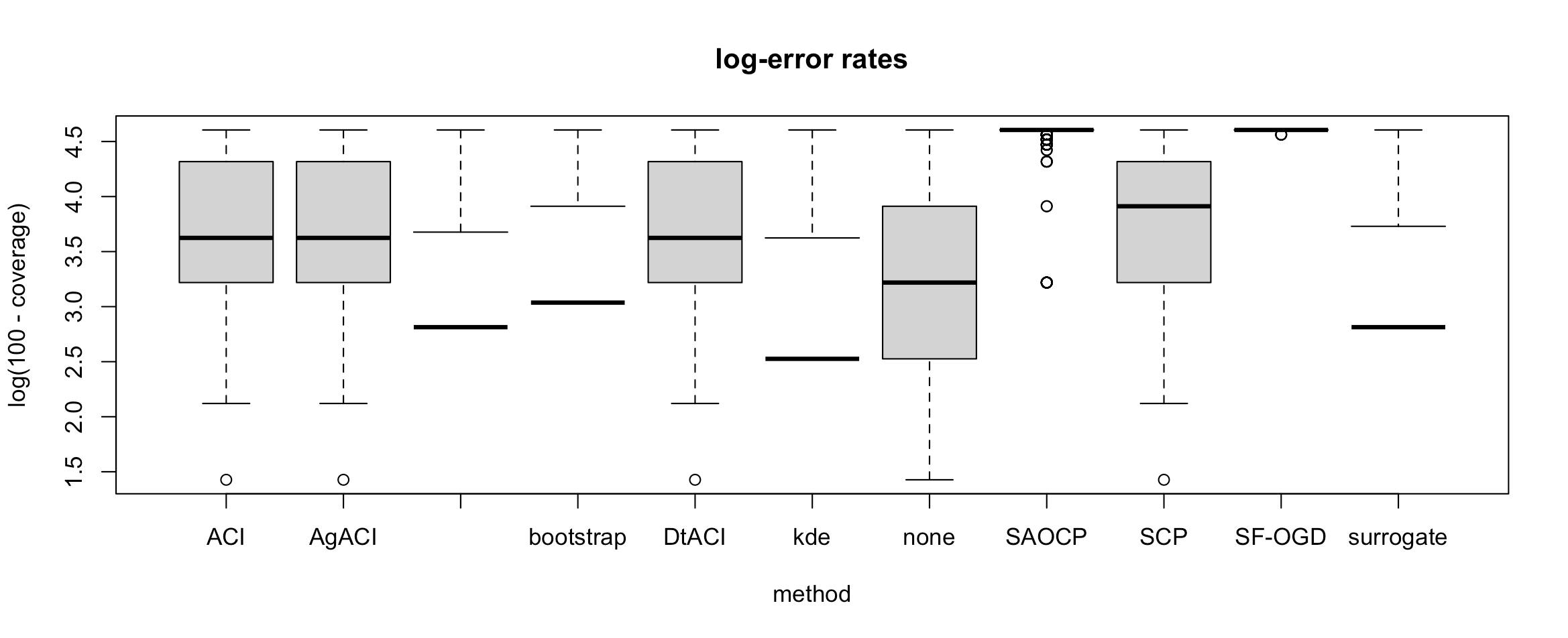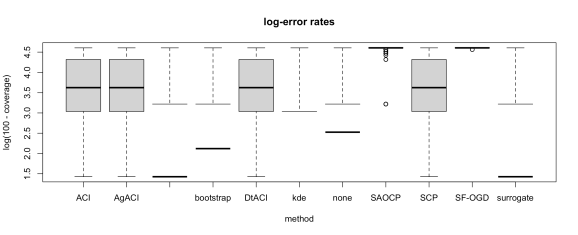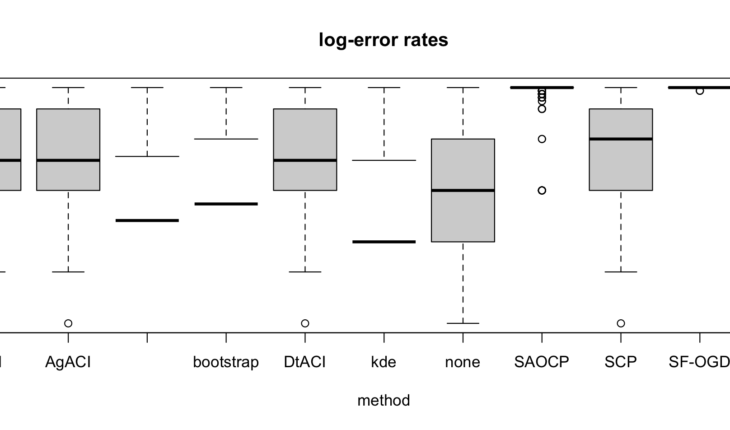In #182, I presented a benchmark based on 30,000 time series, comparing the sequential split conformal method to the state of the art in Conformal prediction for Forecast.
In this post, I’ll present a benchmark based on 1311 time series from the Tourism competition, comparing the sequential split conformal method to the state of the art. Theta method from the forecast package is used as the base model, along with my R package ahead for conformalizing the base model. 2 target coverage levels are considered: 80% and 95%. The benchmarking errors are measured by:
utils::install.packages(c('foreach', 'forecast', 'fpp', 'fpp2', 'remotes', 'Tcomp'),
repos="https://cran.r-project.org")
remotes::install_github("Techtonique/ahead")
remotes::install_github("thierrymoudiki/simulatetimeseries")
remotes::install_github("herbps10/AdaptiveConformal", force=TRUE)
remotes::install_github("thierrymoudiki/misc")
suppressWarnings(library(datasets))
suppressWarnings(library(forecast))
suppressWarnings(library(foreach))
suppressWarnings(library(fpp2))
suppressWarnings(library(ahead))
suppressWarnings(library(AdaptiveConformal))
suppressWarnings(library(misc))
suppressWarnings(library(Tcomp))
coverage_score <- function(obj, actual) {
if (is.null(obj$lower))
{
return(mean((obj$intervals[, 1] <= actual)*(actual <= obj$intervals[, 2]))*100)
}
return(mean((obj$lower <= actual)*(actual <= obj$upper))*100)
}
winkler_score <- function(obj, actual, level = 95) {
alpha <- 1 - level / 100
lt <- try(obj$lower, silent = TRUE)
ut <- try(obj$upper, silent = TRUE)
actual <- as.numeric(actual)
if (is.null(lt) || is.null(ut))
{
lt <- as.numeric(obj$intervals[, 1])
ut <- as.numeric(obj$intervals[, 2])
}
n_points <- length(actual)
stopifnot((n_points == length(lt)) && (n_points == length(ut)))
diff_lt <- lt - actual
diff_bounds <- ut - lt
diff_ut <- actual - ut
score <- diff_bounds
score <- score + (2 / alpha) * (pmax(diff_lt, 0) + pmax(diff_ut, 0))
return(mean(score))
}
get_error <- function(obj, actual, level = 95)
{
actual <- as.numeric(actual)
mean_prediction <- as.numeric(obj$mean)
me <- mean(mean_prediction - actual)
rmse <- sqrt(mean((mean_prediction - actual)**2))
mae <- mean(abs(mean_prediction - actual))
mpe <- mean(mean_prediction/actual-1)
mape <- mean(abs(mean_prediction/actual-1))
coverage <- as.numeric(coverage_score(obj, actual))
winkler <- winkler_score(obj, actual, level = level)
res <- c(me, rmse, mae, mpe,
mape, coverage, winkler)
names(res) <- c("me", "rmse", "mae", "mpe",
"mape", "coverage", "winkler")
return(res)
}
ahead_methods <- c("block-bootstrap", "surrogate",
"kde", "bootstrap")
aci_methods <- c('ACI', 'SCP', 'AgACI',
'DtACI', 'SF-OGD', 'SAOCP')
i <- 3
level <- 95
nsim <- 250
ahead_method <- ahead_methods[1]
aci_method <- aci_methods[1]
# base model
obj <- forecast::thetaf(y=Tcomp::tourism[[i]]$x,
h=Tcomp::tourism[[i]]$h,
level=level)
print(get_error(obj, Tcomp::tourism[[i]]$xx))
# conformalized ahead
obj_ahead <- ahead::conformalize(FUN=forecast::thetaf,
y=Tcomp::tourism[[i]]$x,
h=Tcomp::tourism[[i]]$h,
level=level,
nsim = nsim,
method=ahead_method)
print(get_error(obj_ahead, Tcomp::tourism[[i]]$xx))
# AdaptiveConformal
(obj_aci <- AdaptiveConformal::aci(Y = as.vector(Tcomp::tourism[[i]]$xx),
predictions = as.vector(obj$mean),
method = "ACI",
alpha = level/100))
obj_aci$mean <- as.vector(obj$mean)
print(get_error(obj_aci, Tcomp::tourism[[i]]$xx))
## -----------------------------------------------------------------------------------
ahead_methods <- c("block-bootstrap", "surrogate",
"kde", "bootstrap")
aci_methods <- c('ACI', 'SCP', 'AgACI',
'DtACI', 'SF-OGD', 'SAOCP')
n_series <- length(tourism)
for (level in c(80, 95))
{
pb <- utils::txtProgressBar(min=0, max=n_series, style = 3)
benchmark <- foreach::foreach(i=1:n_series, .combine = rbind)%do%
{
results <- matrix(NA,
nrow= 1 + length(ahead_methods) + length(aci_methods),
ncol=9)
colnames(results) <- c("series", "method",
"me", "rmse", "mae", "mpe", "mape",
"coverage", "winkler")
results_index <- 1
# base model
obj <- forecast::thetaf(y=Tcomp::tourism[[i]]$x,
h=Tcomp::tourism[[i]]$h,
level=level)
results[results_index, ] <- c(i, "none",
get_error(obj, Tcomp::tourism[[i]]$xx))
results_index <- results_index + 1
# conformalized ahead
for (j in 1:length(ahead_methods))
{
obj_ahead <- try(ahead::conformalize(FUN=forecast::thetaf,
y=Tcomp::tourism[[i]]$x,
h=Tcomp::tourism[[i]]$h,
level=level,
nsim = nsim,
method=ahead_methods[j]), silent = TRUE)
if (inherits(obj_ahead, "try-error"))
{
results[results_index, ] <- c(i, paste0("conformal-", ahead_methods[j]), rep(NA, 7))
} else {
results[results_index, ] <- c(i, paste0("conformal-", ahead_methods[j]),
get_error(obj_ahead, Tcomp::tourism[[i]]$xx))
}
results_index <- results_index + 1
}
# AdaptiveConformal
for (j in 1:length(aci_methods))
{
obj_aci <- try(AdaptiveConformal::aci(Y = as.vector(Tcomp::tourism[[i]]$xx),
predictions = as.vector(obj$mean),
method = aci_methods[j],
alpha = level/100), silent = TRUE)
if (inherits(obj_ahead, "try-error"))
{
results[results_index, ] <- c(i, paste0("conformal-", aci_methods[j]),
rep(NA, 7))
} else {
obj_aci$mean <- as.vector(obj$mean)
results[results_index, ] <- c(i, paste0("conformal-", aci_methods[j]),
get_error(obj_aci, Tcomp::tourism[[i]]$xx))
}
results_index <- results_index + 1
}
utils::setTxtProgressBar(pb, i)
results
}
close(pb)
benchmark <- cbind.data.frame(benchmark[, c(1, 2)],
apply(benchmark[, -c(1, 2)], c(1, 2), as.numeric))
benchmark$method <- sapply(1:length(benchmark$method),
function(i) gsub(pattern = "conformal-",
replacement = "",
x=benchmark$method[i]))
saveRDS(benchmark, paste0("2025-01-20-tourism-benchmark", level, ".rds"))
}
Coverage rates and Winkler scores for the 80% and 95% prediction intervals are presented, along with boxplots of the log-error rates (the lower the better).
tourism_benchmark80 <- readRDS("2025-01-20-tourism-benchmark80.rds")
tourism_benchmark95 <- readRDS("2025-01-20-tourism-benchmark95.rds")
benchmark_medians80 <- cbind.data.frame(tapply(tourism_benchmark80$coverage,
tourism_benchmark80$method, median),
tapply(tourism_benchmark80$winkler,
tourism_benchmark80$method, median))
colnames(benchmark_medians80) <- c("coverage", "winkler_score")
misc::sort_df(benchmark_medians80, by="winkler_score")
benchmark_medians95 <- cbind.data.frame(tapply(tourism_benchmark95$coverage,
tourism_benchmark95$method, median),
tapply(tourism_benchmark95$winkler,
tourism_benchmark95$method, median))
colnames(benchmark_medians95) <- c("coverage", "winkler_score")
misc::sort_df(benchmark_medians95, by="winkler_score")
par(mfrow=c(2, 1))
boxplot(log(100-coverage) ~ method, data = tourism_benchmark80,
main="log-error rates")
boxplot(log(100-coverage) ~ method, data = tourism_benchmark95,
main="log-error rates")
coverage winkler_score
surrogate 83.33333 9339.212
block-bootstrap 83.33333 9372.207
kde 87.50000 9419.847
bootstrap 79.16667 10110.819
none 75.00000 11582.445
AgACI 62.50000 17010.164
DtACI 62.50000 17031.145
ACI 62.50000 17165.020
SCP 50.00000 18008.067
SAOCP 0.00000 47472.648
SF-OGD 0.00000 47535.205
coverage winkler_score
surrogate 95.83333 9453.619
block-bootstrap 95.83333 9625.191
kde 100.00000 9705.674
none 87.50000 9845.460
bootstrap 91.66667 10042.757
AgACI 62.50000 16564.417
ACI 62.50000 16649.422
DtACI 62.50000 16649.422
SCP 62.50000 16649.422
SAOCP 0.00000 47472.648
SF-OGD 0.00000 47535.205




So, based on these extensive experiments against the state of the art (and assuming the implementations of the state of the art methods are correct, which I’m sure they are, see https://computo.sfds.asso.fr/published-202407-susmann-adaptive-conformal/, and assuming I’m using them well), how cool is this contribution to the science of forecasting?
Related





